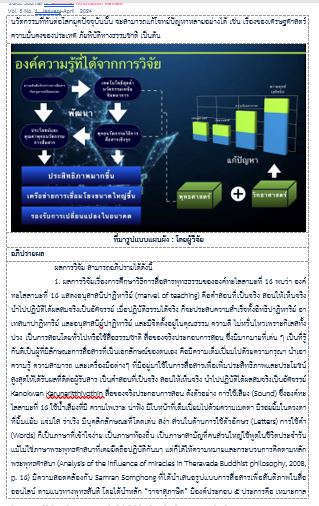AN ANALYTICAL STUDY OF TEMPLES IN THERAVADA BUDDHISM. AS A SOURCE OF INNOVATIVE BUDDHIST COMMUNICATION METHODS
Main Article Content
Abstract
This research article has 3 objectives: 1) study the methods of communicating Buddhist principles during the Buddha's time; 2) study the methods of creating innovative Buddhist communication methods of temples in Theravada Buddhism; 3) analyze the methods of communication of temples in Theravada Buddhism. Currently, as a source of Buddhist communication innovation
Communicating the principles of Buddhist temples during the Buddha's time It happened after the ascetic Siddhartha attained enlightenment. Therefore, he considered the Dhamma (message) that he (the messenger) had enlightenment in for 7 weeks. (At that time there were no temples) He saw that the Dhamma that he had attained was subtle. It's difficult for a person to know. Understand and be able to practice He became discouraged that he would not teach the Dhamma to please the public. Later, he considered it deeply. Then he saw that there were many types of people (receivers) in this world, some of whom could be taught, some of which could not be taught. It is like the four lotuses, so he intends to continue teaching the Dhamma.
When the Buddha gained enlightenment, he went to Rajgir. King Bimbisara and his officials went to see him. After listening to the teachings of the Lord Buddha, he gained faith and dedicated the Weluwan Garden to Buddha. because he saw that it was a peaceful and shady place Suitable for practicing Dhamma. This place is considered to be the first temple in Buddhism, called Wat Weluwan Mahavihara. The teaching of Dhamma or the communication of the Buddha's principles in temples during the Buddha's time took place at Weluwan Temple, the first temple. It was the place where the Lord Buddha performed. The Patimokkha teachings (messages) were given to 1,250 disciple monks (messengers) and sent as missionaries to preach the religion. The Patimokkha teachings that he gave are considered to be the main teachings (message). important or the heart of Buddhism Such principles are divided into 3 parts: 3 principles, 4 ideals, and 6 methods (Sutta Pitaka, Volume 2, Digha Nikaya, Mahavagga - 1. Mahapadana Sutta). And there were also many communication of dharma principles in temples during the Buddha's time. Temples such as Chetawan Nikrodharam Temple. In addition, the Tripitaka also mentions many other temples with a similar history, namely, they were dedicated by rich men or kings who had faith in religion during the Buddha's time. Such as Ampathakaram, Khositaram, Pavarikaram (Pavari Kampavan), etc. Those temples have both the Buddha's performance and the Buddha's teaching through his disciples to perform or communicate after him in the form of oral traditions. (communication channel) or called Buddhist innovation in wireless communication In the Buddha's time
Three months after the Lord Buddha passed into nirvana, 500 Arahants who had listened to his teachings gathered to conduct the First Council at Sattabannakhuha Cave. Near the city of Rajagaha in the Magadha region, it took 7 months of review to successfully compile the Buddha's teachings (messages) for the first time. It is considered the origin of the Pali Tipiṭaka (message). The teachings that were agreed upon in the First Council and have been respected ever since are called Theravada, meaning teachings that were laid down as principles by the Thera. The word Thera here refers to the Elder who convened the first Council. And Buddhism which adheres to the principles that were first discussed is called Theravada sect, which means the group of monks that strictly adheres to the Buddha's teachings, both the words and the contents of the council. As well as preserving even the original language, which is Pali (the message), it can be said to be the creation of Buddhist communication innovations. With the Tripitaka as the message and the disciples as the messengers.
It can be seen that the communication of Buddhist principles during the Buddha's time used the process and communication channels of transmitting teachings by word of mouth. It is communication between people. (Interpersonal Communication) But after the Lord Buddha passed away, Nirvana There were additional channels for communicating about Buddhism, namely printed matter such as the Asoka stone pillar and palm leaves. Later, there was a council. Categorize the teachings into 3 categories or the Tipiṭaka. In terms of communication, it is classified as a printed media.
Currently, there are Theravada Buddhist temples and other places of worship that organize activities that present Dhamma content in new ways. through new media and interesting activities In order to attract Buddhists to pay attention. By inserting Buddhist teachings mixed with communication strategies with various new media. Or it is called Buddhist communication innovation in order to be interesting in communication and focus on presenting the essence of the teachings.
Article Details

This work is licensed under a Creative Commons Attribution-NonCommercial-NoDerivatives 4.0 International License.
เรื่องลิขสิทธิ์/เป็นความคิดเห็นของผู้เขียน
References
Books:
Dhamma Pitaka (P.A.). (2004). Buddhist Method of Teaching. (Bangkok; Sahathamika Limited.
Phra Theppariyatisuthi (Worawit Kongkhapanyo). (2017). Sangha's Manual on Sangha matters. and Religion. Bangkok : Mahachulalongkornrajavidyalaya Printing House.
Mahachulalongkornrajavidyalaya. (1996). Thai Tripitaka Mahachulalongkornrajavidyalaya Bangkok: MCU Press
Somdej Phra Buddhakosajarn (P.A.Payutto). (1975). Fund for building a temple, Wat Wajrirathampathip.New York
Journal:
Phra Witthaya Yanavetee and Phrabaidika Katavoot kavasakatammo (2021). THE EVALUATION OF ACHIEVEMENT OF TRAINING CURRICULUM IN TRAINER MONK DEVELOPMENT PROJECT. Journal of Institute of Trainer Monk Development. (January-June), 4 (1); 27. (in thai)
Thesis:
Benjaporn Techapreechawong (2021). Buddhist Teaching Integration to ICF Coach’s Core Competencies. Doctor of Philosophy Buddhist Studies Graduate School Mahachulalongkornrajavidyalaya University.


